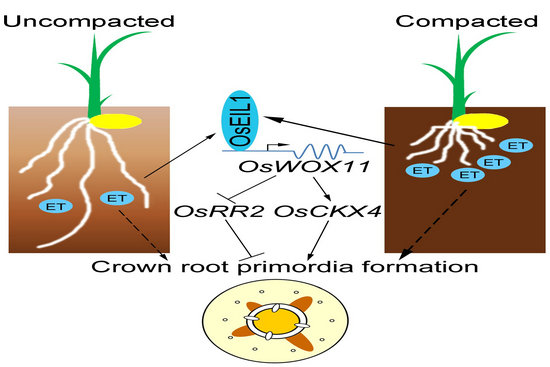Recently, the research group of Dr. Hua Qin and Prof. RongfengHuang from Biotechnology Research Institute, Chinese Academy of Agricultural Scienceshas dissected themolecular mechanism of ethylene in controlling rice crown root development in response to soil compaction.The results are published on Plant Cell with the title of “The OsEIL1–OsWOX11 transcription factor module controls ricecrown root development in response to soil compaction”.
Crown roots are the main component of the fibrous root system in cereal crops.Modulation of crown root growth could enhance crop yields and improve the plant’sability to withstand various adversities. Soil compaction is a serious global problem that impacts crop yields by limitingsoil exploration and resource capture by plants roots. Therefore, elucidating the molecular mechanisms ofcrown root development in response to soil compaction is an important step towards improving root systemarchitecture to enhance yields and other agronomic traits under compacted soil conditions.
Previous studies have shown that soilimpedance increases ethylene biosynthesis and compacted soil restricts diffusion ofethylene. In the present study, we report that ethylene functions as a key signal to stimulate crown rootdevelopment in response to soil compaction. Soil compaction promotes OsEIL1 protein accumulation in roots,which further activates the expression of OsWOX11 to modulate crown rootprimordium initiation and development,thereby increasing crown root number. Our findings provide valuable insights into the regulatory role ofethylene in modulating crown root development in response to soil compaction. Thisunderstanding is vital for the establishment of robust root systems, enabling efficientresource foraging in the soil and enhancing the plant’s chances of survival underdiverse soil conditions.
This work was funded by the National Key R&D Program of China, the National Natural Science Foundation of China, the Central Public-interest ScientificInstitution Basal Research Fund, the Agricultural Scienceand Technology Innovation Program of theChinese Academy of Agricultural Sciences, and the BBSRC fundingand EMBO.

|